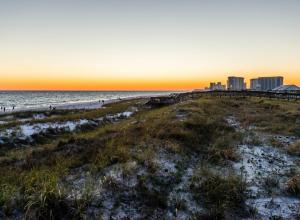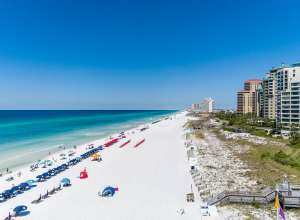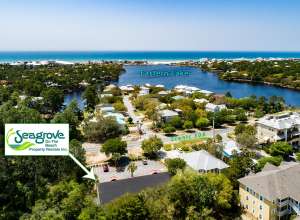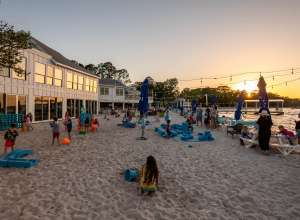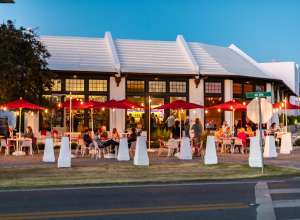Story
Watching For Turtles – Volunteers
April 25, 2014 by Joyce Owen
“I've got a turtle," South Walton Turtle Watch volunteer Bob Veltri shouted, as he scooped up the first turtle and held it gently in his gloved hand. Veltri was the first to dig in the sand as he and his companions looked for traces of the inhabitants of the nest.
Al Murphy, in charge of this night’s dig, brought over a bucket filled with damp sand.

"Very gently put him in the bucket," Murphy instructed.
With Murphy encouraging us, we gathered round as the little sea turtle checked out his new surroundings. Then Veltri moved aside to allow Valerie Mount to scoop small handfuls of sand from the ever-deepening hole.
Long before our beaches lured human visitors to South Walton, sea turtles staked a claim on our sandy shores for their nesting area. Today, while the turtles return to their birthplace to lay eggs, volunteers from South Walton Turtle Watch help to make sure their visits continue.
Every season volunteers discover working with SWTW is a great opportunity to spend time on the beach – not always an option with busy work schedules and the demands of family – and a way to give back to the community.
When my husband and I volunteered for early morning walks searching for turtle tracks, it gave us a renewed sense of the joy and wonder you discover when you take the time to get involved with a program like this.
Looking for the distinctive turtle crawl and checking marked nests for signs of hatching activity is just part of the program. Specially trained volunteers mark nests and later investigate the nests to determine the outcome once the eggs have hatched and the turtles have made their way back to the Gulf of Mexico.
Since volunteers walk in the morning and turtles lay eggs at night, most volunteers never witness a nesting turtle. However, Sharon Maxwell, founder of SWTW, believes everyone should have a chance to see the hatchlings and notifies volunteers when a nest is about to be excavated.
This is a huge reward for volunteers. It’s the reason many walk those countless early morning miles and endure the heat, rain, bugs and tourists with all their questions. Joining a dig can provide the rare opportunity to be with the tiny turtles as they make their way to the Gulf.
 One nest, located in Paradise by the Sea subdivision a half-mile west of Rosemary Beach, had hatched in mid-August the year we volunteered. We got a call to participate in the “dig.”
One nest, located in Paradise by the Sea subdivision a half-mile west of Rosemary Beach, had hatched in mid-August the year we volunteered. We got a call to participate in the “dig.”
Although Maxwell warned that some digs aren’t successful, that night we witnessed an amazing sight.
It was the first dig for Mount and her daughters, Kirsten and Selina. As she brought up a small crusty object, Mount thought she had pieces of a turtle, but was relieved when it crumbled and she realized it was a clump of sand. On her next try she brought up two tiny squirming turtles. Careful not to drop them, she showed them to her daughters and then placed them in the bucket.
After a quick check, Murphy determined they were loggerheads. As the number of turtles in the bucket grew to 10, the tiny creatures climbed over each other looking for a way out. But the damp sand was only a temporary respite until we could release them to the sea.
Veltri continued to dig and remove discarded shells from the newly hatched turtles. Then he found something different.
"There's an egg, now what?" he asked.
Murphy created a spot beside the hole where two piles were soon arranged, one for eggs and the other for discarded shells. A few of the eggs had a moldy look. Murphy explained it was the result of water in the nest.
"Here's one just coming out (of his shell)," said April Hodges, a volunteer for only two months.
"Now, just as far as I can feel ... there are eggs," she said.
For those who had counted the eggs when the nest was first marked, these greenish-gray globes looked sickly. Newly laid eggs are pink and glowing, but with Murphy's experience, he determined most of the eggs looked normal.
The nest originally had 96 eggs. Twelve turtles had been found alive, including two that were still coming out of their shells. Murphy separated the two and they finally wriggled free. One still had yolk on his shell and Murphy worried the turtle might not be strong enough to survive.
He counted the remaining eggs and determined 11 turtles must have already hatched and left the nest. Murphy cut open several eggs to inspect them and made notes for his records.
Murphy walked up and down the beach looking for the right location to relocate the remaining 68 eggs. It had to be high enough to be protected from the water, with a fairly level path to the Gulf.
Once the man-made nest was dug and marked, it was still too sunny to release the turtles. Murphy pointed out Panama City Beach shining brightly in the distance was too far away to distract this group of hatchlings. The houses above the bluff were mostly dark and would provide no distraction as the turtles crawled to the Gulf, he said.
At about 8 p.m., there was only a sliver of moon in the night sky, but the faint glow of the fading sunset would guide the turtles to the water. While our eyes had adjusted to the darkness, it was almost too dark to see the turtles that were covered in sand and only an inch or two in diameter. Murphy advised us to pick a turtle and watch to be sure it got to the water.
The little turtles seemed to know what was expected and crawled forward. It was a long stretch from the sheltered area near the dune to the shore and as they reached the water, a wave pushed them back onto the sand.
Tiny flippers flailed as they struggled. Some turtles flipped over and had to have a little help to get going again, but they persevered and moved forward. The turtles had a long journey. In the first leg of their trip, they will swim for 24 hours to reach the sargassum weed that will provide food and protection.
We watched as the last turtle disappeared into the surf. Kirsten and Selina peered into the water the longest. They even waded out to make sure every last turtle made it to the first sand bar.
Although the odds weren’t great, we all hoped some of our turtles would make it to safety, grow up and come back to lay eggs here one day.


